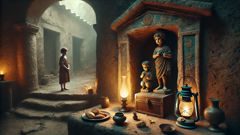Introduction
Janus stands at the hinge of Roman imagination. His likeness, carved in bronze and stone with two solemn faces turned in opposite directions, marks the very idea of change: beginnings and endings, past and future, entry and exit. Walk up to a Roman gate and you will meet his gaze; pass beneath an archway and his presence breathes across the threshold. Ancient Romans invoked Janus when the year turned, when a bridge was crossed, when a new law took effect or a house was opened. He is a god of first things and last things, a deity who holds time in a patient, watchful hand. This portrait of Janus is not only formal: it is intimate, threaded into ritual and daily life. People made offerings to him at ceremonies, closed his temple doors to signal peace, and left them open to signal war. As a guardian of transitions, Janus teaches that every movement forward is shadowed by memory, and every recollection is a step toward something not yet formed. Beyond the rituals and the bronze, Janus lingers in stories where characters stand at crossroads, forced to choose, to remember, or to forgive. His symbol, paired faces looking both ways, is a living metaphor for how cultures negotiate continuity and change. In the following account we explore the ancient rites, the public shrines and private altars, and a fictional yet believable tale set near the Forum Romanum where Janus's influence bends into human destiny. Through history and narrative, the two-faced god becomes a mirror for how Rome made sense of beginnings—seasonal, political, and personal—and how the smallest gesture at a gate could echo across generations.
Origins, Temples, and the Rituals of Threshold
Janus is older than the tangled politics of Rome, older than many of the gods who later found room at the Capitoline. In handfuls of Latin and fragments of Etruscan memory, Janus appears as a guardian of openings, a divinity whose domain is where one place meets another. Archaeological traces and ancient sources suggest his image—two faces on a single head—was a compact explanation of a more abstract power: the watching of time from two directions. To the Roman mind, beginning and ending do not sit at opposite poles but in constant conversation. The earliest temples to Janus were simple, their ritual straightforward: incense, libations, the naming of new ventures. Yet a single gesture—the closing of the metal doors of Janus's shrine—carried a political weight so heavy it could frame the memory of entire eras. The Janus Geminus, an archaic shrine said to stand near the Forum, held doors that remained open in wartime and closed in peace. Ancient chroniclers record far fewer closings than openings; peace, it seemed, was precious and fragile.

Places consecrated to Janus were not always grand. Private homes placed small figurines near thresholds, and families invoked his name when a child first walked out the front door, when a marriage created a new household, when a funeral procession left for a tomb. For farmers and craftsmen, Janus presided over the beginning of the plowing season or the first forge-fire. The calendar itself bore his mark: Ianus gave his name to Ianuarius, the first month. When Romans marked the New Year, they did not simply mark a date; they recognized a state of mind, the pivot between what was and what might be. The naming of the month linked civic time to cosmic patterning, folding private beginnings into public rhythm.
Ritual offerings to Janus could be austere. In many accounts, he accepted the simplest things: salt, bread, oil, a small sprig of laurel. Offerings were made at dawn and dusk, at openings and upon the first day of a journey. Frequently invoked at the mutability of borders, Janus also bridged the liminal: doorways are sacred because they are transitions between inside and outside, safety and exposure, known and unknown. Because of his liminality, Janus's influence extended into legal and political acts. When laws came into effect, they were moved under Janus's watch; when treaties were broken, the city might reopen the doors of his shrine as if to admit the unrest. The rhetorical power of Janus lay in the fact that every civic performance—triumph, treaty, census—passed through thresholds, and the god who attended to thresholds thus sat at the heart of Roman identity.
Art and iconography captured this paradox in visual shorthand. Two faces on one head—sometimes youthful and bearded, sometimes both bearded, sometimes one young and one old—reminded worshippers that past and future are inseparable. Inscriptions and votive offerings sometimes call on Janus with epithets that emphasize his jurisdiction: lord of gates, opener, closer, opener of ways. Poets and orators found in Janus a rhetorical device, a way to pause at the cusp of argument or ceremony and give that pause a sacred frame. Janus's doors—whether of a city shrine or a household—were not merely physical. To close them was to announce an epoch of peace; to open them was to resume motion. The rarity of closure in Roman memory suggests something fundamental about the Roman state: motion, conquest, expansion were embedded in its identity, and so a god who could render stillness sacred was paradoxically central.
Janus is also bound to mythic origins that change with time. In some accounts, he is a pre-Titular god, an old deity whose identity becomes overshadowed by Jupiter and others but who remains essential because thresholds cannot be undone. Later writers create genealogies, make him the father or precursor to more familiar gods, or fold him into the variegated tapestry of Rome's religious life. But whether at the level of myth or domestic rite, Janus retained a consistent presence: he was invoked at beginnings, called upon at openings, and remembered at closings. His two-faced image taught Romans to look both ways—to honor lineage while accepting possibility—in a culture that valued ancestral continuity even as it pursued new territories.
Janus's religious office was performed by priests whose duties were public and private. Clothing and gestures were precise; offerings were timed to the rhythm of lunar months and civic calendars. Public festivals recognized the liminal character of life in a more pronounced way: new magistrates performed rites at thresholds, military commanders invoked Janus before campaigns, and when new infrastructure—bridges, gates, roads—was dedicated, Janus's name was invoked. Such practices made the god a living interface between citizens and the polis. The Janus of ritual therefore was not merely a mythological figure, but an active agent in the governance of communal life. Crossing a bridge or marching through a gate became an act of recognition: a nod toward continuity, a pronouncement of temporal movement.
Even the language of Roman law and literature carries Janus's shadow. Expressions about openings, commencements, and endings bear his trace in idiom and metaphor. Janus occupies a linguistic space that remains in modern tongues; his memory survives in the month that begins the year and in the recurring image of two faces—sometimes invoked to speak of duplicity, more often as a symbol of balanced perspective. He compels one to consider that to open is not only to begin but to risk; to close is to end yet preserve. In a city of constant traffic, Janus taught deliberation at every step. The rituals, temples, and daily gestures that honored him reveal both an ancient theology of thresholds and a social theology of how Rome maintained itself between motion and rest.
A Gatekeeper's Vision: A Tale from the Forum
The city moved around its gates like water around a stone. Traders, soldiers, refugees, and senators passed beneath arches that framed the sky, while children chased between pylons and dogs slept in pools of sun. On the eastern approach to the Forum, beside a modest shrine to Janus, a gatekeeper named Marcus kept watch. Marcus was not a man of high station; his hands were thick from handling bolts and ropes, his hair salted with an early gray. Yet the care he took at every threshold was meticulous. He had been born in a street that smelled of garum and fresh bread; he had seen the walls of the city repaired more times than he could recall. He performed the small rites owed to Janus each dawn and each dusk, setting out water and bread, murmuring the names of family who had passed and whispering a hope for those yet to be born.

The year in which Marcus's story begins had a brittle winter and then a sudden thaw. Rumors arrived at the gate like birds: talk of a distant commander who had taken a border town, talk of a law that might rearrange grain distributions, talk of a senator's sudden illness. The city was a knotted rope of rumor and fact, and every rumor tugged at thresholds. On an evening when lanterns threw trembling light across the stones, a patrol returned and reported that the doors of Janus Geminus had remained open through the day. Peace, it seemed, was not secure. Marcus tightened the rope on his gate and felt the old weight at the center of the city—the sensation that small acts might be counted and that ritual might hold back the drift of disorder.
Marcus lived in a house that smelled of resin and old wood, with a narrow window that looked toward the temple. He had a daughter, Livia, who stitched garments for local patrons. The simplicity of their lives was a kind of devotion: steady, repeated actions that measured days. Yet like most Romans, they were subject to the city's larger swings. Marcus remembered a time when the city sealed Janus's doors and a hush fell over the Forum so total that even the pigeons seemed to stop mid-flight. People wore that hush like a garment, more grateful for it than they had words to show. The memory of that quiet made Marcus careful; he doubled his small rituals on nights of rumor, placing extra oil in the lamp, setting a small coin at Janus's feet, whispering the names of names he had promised to recall.
One dawn, as the mist lifted and street sellers arranged their wares, Marcus encountered an old woman standing at the shrine. She was wrapped in a threadbare cloak. Her eyes were bright and unsettlingly clear. She held a small carved token, a two-faced head no larger than a child's palm. Marcus had seen such tokens for sale near the markets and had never given one thought; now the token seemed to hold the weather. The woman spoke in a voice like stone rubbed smooth. She asked Marcus to set the token upon Janus's plinth and to close his eyes. He complied. The carved faces looked in opposite directions, and the woman's fingers were quick, singular as a ritual.
Marcus's vision came before he completed the prayer. He saw a long road that led out of the city and then doubled back like a ribbon. On one side of the ribbon lay his father's hands—calloused, strong, shaping bricks and speaking in soft, authority-soaked syllables. On the other side he saw his daughter's small shadow, moving fast ahead through a winter of smoke and then into a field of light he had not yet seen. Between these two images rose the twin faces of Janus, enormous and calm, one face carrying memory and the other carrying possibility. The god did not speak in words but in weight: each moment of Marcus's life was a hinge. He felt grief for what had been and a strange, patient hope for what lay ahead.
When the vision tapered and Marcus opened his eyes, the old woman was gone. The market's noise returned like the sea. Marcus kept the carved token for himself and brought it home as if he had rescued a child's toy. He confided little to Livia, but she saw the shadow among his eyes and guessed a story was being kept like bread for hard times. For weeks, Marcus performed his duties with a new steadiness. He found himself watching travelers not merely to secure the gate but to learn what their faces might teach. In one passing caravan he saw a man who had a hand scarred in the exact pattern of Marcus's father's mark; he imagined a kinship with a stranger and offered a brief greeting. The stranger told of a bridge being repaired near the frontier. Marcus, who had known the work of bridges and gates since childhood, felt the tug of that larger world and a renewed sense that his small acts mattered.
Not all nights were patient. An argument broke out on the steps of the shrine between two traders over a debt and the matter escalated until a soldier intervened. That evening the doors of Janus remained open—wider, it felt, because the argument had spilled over into the public space. People muttered. The city's breath grew thin. Marcus thought of the vision—the ribbon road, his father's hands, Livia's small shadow—and understood that he stood between more than stone. He stood between memory and continuance.
When a messenger arrived with word that a minor skirmish at a distant outpost had widened, people brought votive offerings in a flood. The temple of Janus filled with voices. Families insisted on names and histories, and soldiers petitioned for safe passage. Marcus found himself at the liminal center of a city that was preparing to move. He performed the ceremony he had performed since boyhood, but now with the carved token in his pocket. At the end of the rite, under a sky that changelessly kept its colors, Marcus approached the gate with Livia at his side. She had woven a strip of cloth into the knot of his rope, and together they loosened the latch.
As the gate opened, Marcus felt a hand on his shoulder. It was not the hand of a magistrate or a soldier but the presence of the city itself, felt as if from the stone beneath his sandals. He had always thought ritual was a human device, a way to claim order out of chaos; but in that moment he sensed an exchange. To open a gate is to accept the world as a place where movement happens, where history presses and sometimes bruises. To close a gate is to say that the moment deserves shelter. Marcus had been given a vision of both states. He could not stop the skirmish in the outpost, and he could not command the city's ambitions. But he could place a coin of memory and a lamp of hope at Janus's feet, and that small anchoring altered how he moved.
Years later, after wars had swept and treaties had been forged, when Marcus's hair had turned almost wholly silver, the city's record would note that the doors of Janus had been closed for a season of peace. The chroniclers would mark dates and names, politicians would claim credit, and the small details would be footnotes. Yet in the household where Marcus's granddaughter would sit by an oil lamp and listen to stories of gates, a different memory would persist: the tale of a man who kept his post and who learned to regard every crossing as both an ending and a beginning. The carved token would be passed on, worn smooth by years of fingers tracing its twin faces. In stories told under the hush of night, Janus would become a teacher of patience, an insistence that the past's weight does not crush the possibility of what comes next. Marcus's vision had not altered the fate of empires, but it altered the small compass by which his family navigated the city's tides.
That is perhaps the essential power of Janus: not the ability to decide great wars or declare emperors, but the capacity to sanctify a small human choice. In every household, in every gate, in every pause between breath and step, Rome remembered that beginnings require ritual, that memory requires naming, and that the future demands vigilant welcome. To stand at a threshold and look both ways is to recognize that life is made of contiguous acts—remembrance, choice, and the willingness to step. In the bronze gaze of a two-faced head, Marcus and his descendants found a practice for living: to honor the past without surrendering the future, to close what must be closed and to open what must be opened, and to greet each passing with a steady hand.
Conclusion
Janus endures because his form answers a human need: to name the moment when one thing ends and another begins. Across centuries, cultures have looked for symbols to hold those instants and to make them sacred. Janus furnished Rome with a language of thresholds that touched public life and private habit alike. He taught that to open is to risk and to close is to preserve; he taught that memory and anticipation share a face. In modern expression Janus often becomes shorthand for duplicity, but that is a partial reading. More richly, Janus invites a balanced gaze—one that bows to history and keeps a watchful eye on possibility. Whether in bronze at a gate, in a token kept on a mantle, or in the metaphorical threshold of a personal choice, Janus remains a companion for moments of change. If we are to stand where stones and seasons meet, we can take from Janus a pragmatic grace: name what has been, honor it, and with measured courage, step. The two faces do not speak in competition but in conversation, and that conversation is the quiet engine of lives that span gates and generations.













